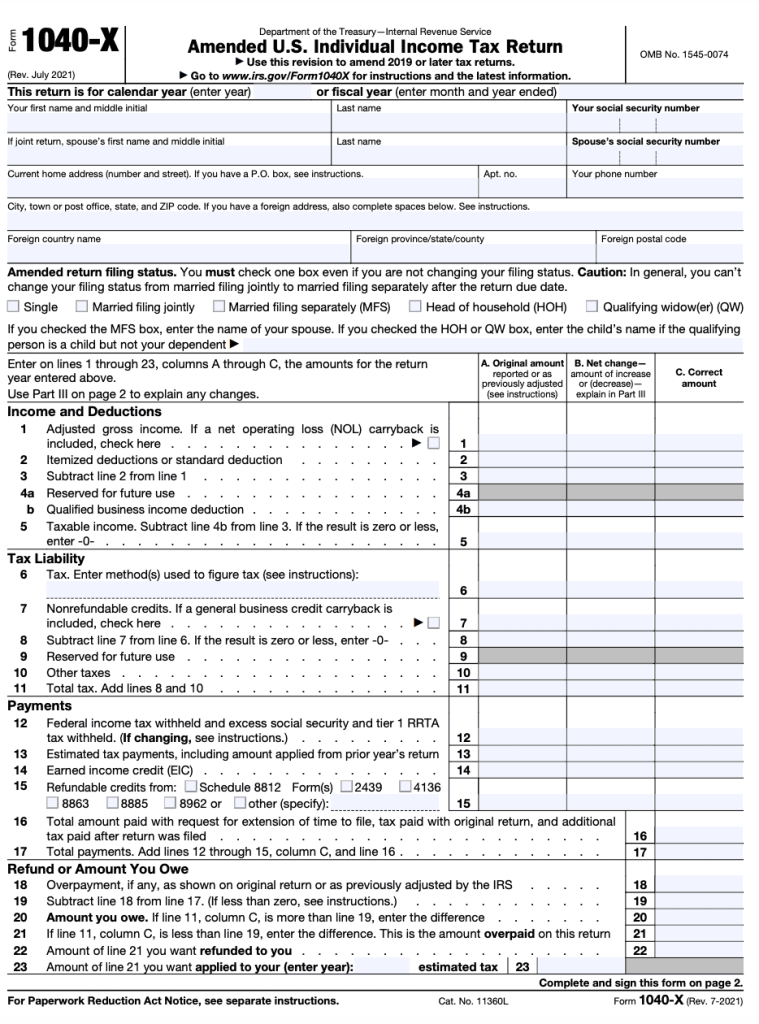Amended Tax Returns: When and How to Correct Your Filed Taxes
If you discover an error after filing a tax return, the IRS allows you to correct it by filing an amended tax return. Some mistakes are minor and the IRS will automatically correct them, but other changes must be handled by filing Form 1040-X, Amended U.S. Individual Income Tax Return.

This guide explains when you should amend a tax return, what form to use, filing deadlines, how adjustments work, and important rules to follow when correcting your tax filing.
When You Should File an Amended Return
You should file Form 1040-X if any of the following need to be corrected:
- Filing status (example: Single to Married Filing Jointly)
- Income changes or missing income documents (W-2s, 1099s)
- Deductions that were incorrectly claimed or omitted
- Credits that were calculated incorrectly
- Updates to dependent information
These types of changes affect your tax liability and require official correction through an amended return.
When You Do Not Need to Amend
You generally do not need to file Form 1040-X if:
- You made only math or calculation errors
- Forms or schedules were missing but the return is otherwise correct
- The IRS contacted you requesting additional documentation
In these cases, the IRS can correct or request missing information without requiring a full amended return.
How to File an Amended Tax Return
Form 1040-X is used to correct previously filed:
- Form 1040
- Form 1040-A
- Form 1040-EZ
- Form 1040-NR or 1040-NR-EZ
You must file one Form 1040-X per year being amended and mail each year in separate envelopes. The tax year being amended must be clearly listed at the top of the form.
Understanding the Columns on Form 1040-X
| Column | Description |
|---|---|
| Column A | Amounts from your original return or last IRS adjustment |
| Column C | Correct amounts after your changes |
| Column B | Difference between Columns A and C |
You must also provide a written explanation on the form describing the reason for each change.
Attach all related documents such as corrected W-2s, 1099s, schedules, or forms supporting the revised entries.
Deadlines for Filing an Amended Return
To claim a refund, you must file Form 1040-X by the later of:
- Three (3) years from the date the original return was filed, or
- Two (2) years from the date the tax was paid
Returns filed early are treated as filed on the due date. Different rules may apply for:
- Net operating loss carrybacks
- Foreign tax credits
- Bad debts
If you owe more tax, submitting Form 1040-X and paying the balance by the tax due date avoids penalties and interest.
How to Track Your Amended Tax Return
You can check your amended return status using:
- Where’s My Amended Return? online tool at IRS.gov
- IRS hotline: 866-464-2050
Tracking becomes available approximately 3 weeks after the IRS receives the amended return.
The tool displays three status stages:
- Received – IRS has logged the amendment
- Adjusted – IRS finished reviewing and made account changes
- Completed – Processing is fully finished
Amended returns typically take up to 20 weeks or longer due to manual handling.
Important IRS Rules for Amending a Tax Return
These long-standing IRS rules apply to amended filings:
- Amending is not required unless the original return was knowingly incorrect.
- All necessary corrections must be included. You cannot choose only refund-increasing changes.
- Math errors or missing attachments usually do not require amending.
- Refund claims must follow the 3-year / 2-year statute of limitations rules.
- Each tax year must be amended separately using separate Form 1040-X filings.
- Amended returns often receive closer review, increasing the likelihood of examination.
- Refunds from amended returns can be applied to estimated taxes for the current year.
- Filing an amended return does not extend the statute of limitations for IRS assessment unless tax is increased close to the deadline.
- If additional tax is owed, interest and penalties may apply based on original due dates.
Additional State Tax Impacts
Changes made on a federal amended return can affect your state income taxes.
If applicable, file a separate amended return with your state tax agency to keep your records accurate.
Summary
Form 1040-X allows taxpayers to correct important mistakes made on previously filed federal returns. Amend only when required, follow deadlines carefully, and include all supporting documentation. Tracking information is limited, and processing may take several months due to manual review.
